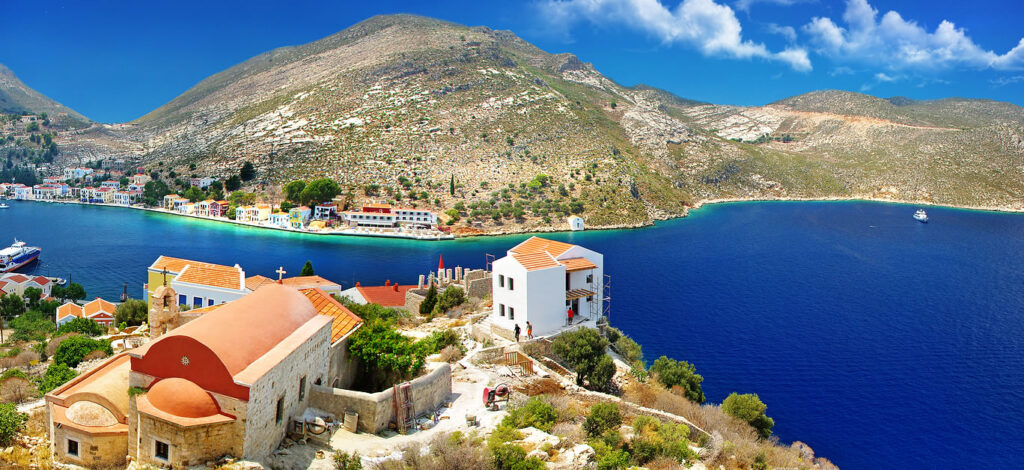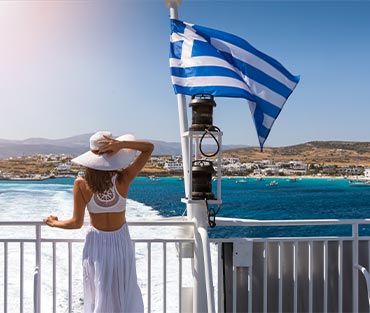Imagine embarking on a journey through the breathtaking Greek islands, where crystal clear turquoise waters surround you and ancient ruins await your exploration. Whether you’re a seasoned traveler or a first-time island hopper, Greece offers an enchanting experience that will captivate your heart. In this beginner’s guide, we will take you on a virtual tour of the Greek islands, sharing insider tips on how to make the most of your island hopping adventure. From the iconic Santorini to the hidden gems of Crete, get ready to dive into the irresistible charm of Greece.

Choosing the Greek Islands to Visit
When planning a trip to Greece, one of the most exciting decisions you’ll make is choosing which Greek islands to visit. With over 200 inhabited islands to choose from, each with its own unique charm and beauty, it can be overwhelming to narrow down your options. To help you make the best decision for your trip, there are a few key considerations to keep in mind.
Considerations for choosing islands
Firstly, consider what you’re looking for in a Greek island experience. Are you seeking vibrant nightlife and bustling beaches, or do you prefer a more laid-back and remote atmosphere? Are you interested in historical sites and cultural attractions, or do you simply want to relax on pristine beaches and swim in crystal-clear waters? Thinking about what you value the most in a vacation will help you choose the islands that best align with your preferences.
Another important consideration is your travel budget and time constraints. Some Greek islands, like Santorini and Mykonos, are more popular and therefore tend to be more expensive. If you’re on a budget, you might want to explore some of the lesser-known islands, where you can find affordable accommodations and activities.
Lastly, think about the logistics of island hopping. Consider which islands are located in close proximity to one another, as this will make it easier and more efficient to travel between them. Ferry connections and domestic flights are common ways to get around, and choosing islands that are well-connected can save you time and hassle during your trip.
Popular Greek islands to consider
Some of the most popular Greek islands, which are frequently visited by travelers from around the world, include Santorini, Mykonos, Crete, Rhodes, and Corfu. Each of these islands offers its own unique attractions and experiences.
Santorini is famous for its stunning sunsets, picturesque villages perched atop cliffs, and breathtaking views of the Aegean Sea. Mykonos, known for its vibrant nightlife and beautiful beaches, is a favorite among party-goers and beach lovers. Crete, the largest of the Greek islands, boasts a rich history, charming coastal towns, and beautiful landscapes, including the Samaria Gorge. Rhodes offers a perfect blend of history and relaxation, with its well-preserved medieval town and sandy beaches. Corfu, located in the Ionian Sea, is known for its lush greenery, crystal-clear waters, and Venetian architecture.
Off-the-beaten-path islands to consider
For those seeking a more authentic and off-the-beaten-path experience, there are several lesser-known Greek islands that are worth exploring. Naxos, the largest of the Cyclades islands, offers beautiful beaches, traditional villages, and ancient ruins. Milos, known for its unique rock formations and colorful beaches, is a hidden gem in the Aegean Sea. Kefalonia, with its stunning coastline and dramatic landscapes, is a paradise for nature lovers. Paros, a charming island with picturesque villages and sandy beaches, is often overlooked by tourists. Finally, Symi, a small island with colorful neoclassical houses and a tranquil atmosphere, is perfect for those seeking peace and relaxation.
Planning Your Trip
Once you have decided on the Greek islands you want to visit, it’s time to start planning your trip. There are a few important factors to consider in order to make your island hopping adventure a success.
Determining the duration of your trip
The duration of your trip will largely depend on how many islands you plan to visit and how much time you have available. It’s important to strike a balance between exploring multiple islands and allowing yourself enough time to fully experience and enjoy each one.
A good rule of thumb is to spend at least 3-4 days on each island, although this can vary depending on the size and attractions of the island. If you have a limited amount of time, consider focusing on a smaller number of islands to make the most of your trip.
Deciding on the best time to visit
The best time to visit the Greek islands largely depends on your personal preferences and what you want to do during your trip. The peak tourist season in Greece is during the summer months of June, July, and August when the weather is warm and sunny. However, this is also the busiest time, with more crowds and higher prices.
If you prefer a quieter and more relaxed atmosphere, consider visiting in the shoulder seasons of May and September. The weather is still pleasant, and you’ll have more opportunities to explore without the crowds. For those who enjoy water activities, such as swimming and snorkeling, the summer months are the best choice as the sea temperature is perfect for a refreshing dip.
Booking flights and accommodations
When it comes to booking your flights and accommodations, it’s best to start early to secure the best deals and availability. There are several ways to reach Greece, with Athens serving as the main gateway. From there, you can either take a domestic flight or a ferry to your chosen islands.
When booking accommodations, consider staying in a mix of hotels, guesthouses, or rental properties to get a taste of different island experiences. Websites like Booking.com and Airbnb offer a wide range of options catering to different budgets and travel styles.
It’s also worth considering the option of booking a package tour, especially if it’s your first time visiting Greece or if you prefer having the convenience of organized transportation and activities. Many tour operators offer island hopping packages that include flights, accommodations, and transportation between islands.
Getting Around the Greek Islands
Getting around the Greek islands is an important aspect of planning your trip. With various transportation options available, it’s essential to choose the most convenient and efficient method for island hopping.
Ferry travel between islands
Ferries are a popular mode of transportation for traveling between the Greek islands. There are several ferry companies operating in Greece, offering regular schedules and connections to most islands. The frequency of ferry services may vary depending on the season, with more options available during the peak summer months.
When planning your itinerary, check the ferry schedules and consider the travel time between islands. Some routes might require overnight travel, so plan accordingly and book your accommodation accordingly.
Domestic flights within Greece
If you’re short on time or prefer a quicker mode of travel, domestic flights are available between some Greek islands. Major airlines such as Aegean Airlines and Olympic Air operate flights to popular destinations such as Santorini, Mykonos, and Crete.
It’s important to note that while flying is faster, it might not offer the same scenic experience as ferry travel. Additionally, flights tend to be more expensive, so factor in the cost when planning your budget.
Rental cars and other transportation options
Renting a car is a great option for exploring the islands at your own pace and convenience. Most Greek islands have car rental services available, allowing you to easily navigate from one destination to another. However, it’s worth considering that parking can be limited in some areas, especially during the peak tourist season.
Alternatively, public buses and taxis are available on many islands, providing a convenient way to get around. Local buses are often cheaper and offer routes to popular attractions and towns. Taxis, while pricier, are a good option for shorter distances or when traveling in a group.
Packing Essentials for Island Hopping
Packing for your island hopping adventure is an important task to ensure you have everything you need to make the most of your trip. Here are some essential items to consider when packing for your Greek island getaway.
Clothing and footwear
When it comes to clothing, pack lightweight and breathable fabrics to keep cool in the Mediterranean heat. Opt for comfortable and versatile pieces that can easily be mixed and matched. Essentials include t-shirts, shorts, sundresses, and lightweight trousers or skirts.
Don’t forget to pack a light sweater or jacket for cooler evenings, especially if you’re traveling in the shoulder season. Also, keep in mind that some religious sites, such as churches and monasteries, require modest attire, so it’s a good idea to have a scarf or shawl to cover your shoulders.
In terms of footwear, bring comfortable walking shoes or sandals for exploring the islands and sturdy water shoes for swimming and water activities. It’s also advisable to have a pair of closed-toe shoes for any hiking or outdoor adventures.
Beachwear and swimwear
No trip to the Greek islands would be complete without spending some time at the beach. Make sure to pack your favorite swimsuits and beachwear, including cover-ups, sarongs, and flip-flops. Don’t forget a beach towel, sunscreen, a hat, and sunglasses to protect yourself from the sun.
Sun protection and essentials for hot weather
The Greek islands are known for their sunny and hot weather, so sun protection is essential. Pack a high SPF sunscreen, lip balm with SPF, and aloe vera gel for soothing any sunburns. It’s also a good idea to bring a reusable water bottle to stay hydrated throughout the day.
Other essentials to consider include a small backpack or day bag for carrying your belongings, a travel adapter for charging your electronics, and a waterproof phone case or pouch for protecting your electronics near water.

Navigating the Greek Island Culture
Understanding the local customs and etiquette of the Greek islands will not only enhance your travel experience but also show respect to the local people and their traditions. Here are a few key points to keep in mind.
Understanding Greek island customs and etiquette
Greeks are known for their warm and welcoming hospitality, and it’s important to reciprocate that kindness. Greet locals with a friendly “yasou” (hello) or “kalimera” (good morning), and don’t be afraid to engage in conversations with the locals. Greeks appreciate politeness and friendliness, so do your best to be respectful and polite.
Dress modestly when visiting churches and monasteries, covering your shoulders and knees. It’s also customary to remove your shoes before entering someone’s home, so be mindful of this if invited to someone’s house.
Language considerations and useful phrases
While English is widely spoken in tourist areas, learning a few basic Greek phrases can go a long way in interacting with the locals and showing your appreciation for their culture. Some useful phrases include “efcharisto” (thank you), “parakalo” (please), and “signomi” (excuse me). English-Greek phrasebooks or translator apps can be handy for communication.
Currency, tipping, and payment options
The official currency in Greece is the Euro (€). While credit cards are widely accepted in most establishments, it’s always a good idea to carry some cash for small purchases and places that might not accept cards. ATMs are readily available on the islands for convenient cash withdrawal.
Tipping in Greece is customary, with a 10% tip being the norm in restaurants, cafes, and bars. It’s also customary to leave a small tip for hotel staff and taxis, rounding up the bill.
Exploring the Popular Greek Islands
Now that you’ve planned your trip and familiarized yourself with the logistics and cultural aspects of island hopping in Greece, it’s time to explore some of the most popular Greek islands and discover their unique attractions.
Santorini
Santorini is often regarded as one of the most beautiful and romantic islands in Greece. The iconic white-washed buildings, blue-domed churches, and breathtaking Caldera views make Santorini a must-visit destination. Explore the picturesque villages of Fira and Oia, visit the ancient site of Akrotiri, and relax on the famous beaches of Kamari and Perissa.
Mykonos
Known for its vibrant nightlife and cosmopolitan atmosphere, Mykonos attracts party-goers and celebrity sightings from around the world. Explore the charming narrow streets of Mykonos Town, visit the iconic windmills, and relax on the beautiful beaches of Paradise and Super Paradise.
Crete
Crete is the largest of the Greek islands and offers a diverse range of experiences. Visit the ancient Palace of Knossos, explore the charming old town of Chania, and hike the stunning Samaria Gorge. Crete is also home to beautiful beaches, such as Balos and Elafonisi, where you can soak in the sun and swim in turquoise waters.
Rhodes
Rhodes is a treasure trove of history and culture, with its well-preserved medieval town and ancient archaeological sites. Explore the charming streets of Rhodes Old Town, visit the ancient city of Kamiros, and relax on the beautiful beaches of Lindos and Faliraki.
Corfu
Located in the Ionian Sea, Corfu offers a lush and green escape. Explore the charming Venetian architecture in Corfu Town, visit the stunning beaches of Paleokastritsa and Glyfada, and take a boat trip to the enchanting island of Vlacherna.

Discovering Off-the-Beaten-Path Greek Islands
While the popular Greek islands are undoubtedly beautiful, there’s a certain charm to be found on the lesser-known islands. Here are some off-the-beaten-path Greek islands that are worth exploring.
Naxos
Naxos, the largest of the Cyclades islands, is a paradise for nature lovers. With beautiful beaches, mountainous landscapes, and traditional villages, Naxos offers a perfect blend of relaxation and exploration. Visit the picturesque village of Halki, hike to the summit of Mount Zeus, and relax on the sandy beaches of Agios Prokopios and Plaka.
Milos
Milos is known for its unique rock formations, colorful beaches, and tranquil atmosphere. Explore the stunning caves and rock formations at Kleftiko, visit the charming fishing village of Klima, and relax on the beautiful beaches of Sarakiniko and Firiplaka.
Kefalonia
Kefalonia offers stunning coastal landscapes, crystal-clear waters, and charming villages. Visit the picturesque village of Assos, explore the underground lake of Melissani Cave, and relax on the beautiful beaches of Myrtos and Antisamos.
Paros
Paros is a hidden gem with picturesque villages, sandy beaches, and a laid-back atmosphere. Visit the charming town of Naoussa, explore the traditional village of Lefkes, and relax on the beautiful beaches of Kolymbithres and Golden Beach.
Symi
Symi, a small and tranquil island, is perfect for those seeking peace and relaxation. Explore the colorful neoclassical houses in Symi Town, visit the Monastery of the Archangel Michael Panormitis, and enjoy the tranquility of the secluded beaches like Nos and Agios Georgios.
Must-Visit Attractions on the Greek Islands
Apart from the natural beauty, the Greek islands are also home to a wealth of historical and cultural attractions. Here are some must-visit attractions that should be on your itinerary.
Ancient ruins and archaeological sites
Greece is known for its rich history, and the Greek islands are dotted with ancient ruins and archaeological sites. Visit the ancient city of Akrotiri in Santorini, explore the Palace of Knossos in Crete, and discover the Acropolis of Lindos in Rhodes.
Beautiful beaches and crystal-clear waters
One of the main reasons travelers flock to the Greek islands is the beautiful beaches and crystal-clear waters. From the red sands of Red Beach in Santorini to the pink sands of Elafonisi Beach in Crete, there is a beach to suit every preference. Don’t miss the stunning Shipwreck Beach in Zakynthos and the famous Navagio Beach.
Charming traditional villages and towns
The Greek islands are home to charming traditional villages and towns that offer a glimpse into the local way of life. Explore the narrow streets of Oia in Santorini, wander through the old town of Chania in Crete, and immerse yourself in the romantic atmosphere of Lindos in Rhodes.

Experiencing Greek Island Cuisine
No trip to Greece would be complete without indulging in the delicious and flavorful Greek cuisine. Here are some traditional dishes, local delicacies, and recommended restaurants to try during your island hopping adventure.
Traditional Greek dishes to try
Start your culinary journey with traditional Greek dishes such as moussaka (layers of eggplant, minced meat, and béchamel sauce), souvlaki (grilled meat skewers), and spanakopita (spinach and feta cheese pie). Don’t forget to try the iconic Greek salad with fresh tomatoes, cucumbers, olives, and feta cheese, topped with olive oil and oregano.
Local delicacies and specialties
Each Greek island has its own local delicacies and specialties to try. In Santorini, taste the unique cherry tomato, white eggplant, and the famous Vinsanto wine. In Crete, sample the delicious dakos (Cretan bruschetta), snails cooked in tomato sauce, and the island’s famous cheese, graviera.
Recommended restaurants and tavernas
While exploring the Greek islands, be sure to seek out local tavernas and restaurants to savor the authentic flavors. In Santorini, don’t miss the cliffside dining experience at Ammoudi Fish Tavern in Oia or enjoy sunset views from Sphinx Restaurant in Fira. In Mykonos, try the fresh seafood at Kiki’s Tavern in Agios Sostis Beach or indulge in a gourmet dinner at Interni in Mykonos Town.
Budgeting for Island Hopping in Greece
Island hopping in Greece can be done on a range of budgets, depending on your preferences and travel style. Here are some cost considerations to keep in mind when planning your trip.
Cost considerations for accommodations
The cost of accommodations can vary greatly depending on the location, season, and type of accommodation you choose. Luxury resorts and boutique hotels in popular tourist areas tend to be more expensive, while guesthouses and apartments in smaller villages offer more affordable options. Consider balancing your budget by staying in a mix of accommodation types throughout your trip.
Transportation expenses
Transportation costs can also vary depending on your chosen mode of travel. Ferries are generally more affordable than domestic flights, but the prices can still vary depending on the distance and type of ferry. Rental cars provide flexibility but come with additional costs such as fuel, parking fees, and insurance. Public buses and taxis are more budget-friendly options for getting around on the islands.
Meal and entertainment budgeting
Food and dining expenses can range from budget-friendly tavernas to high-end gourmet dining experiences. Set aside a budget for meals and drinks, allowing yourself to indulge in local specialties while also enjoying some home-cooked meals or picnics to save money. Consider including some budget-friendly activities such as hiking, visiting public beaches, or exploring local markets to balance out any higher-cost attractions or tours.
By considering these budgeting factors, you can plan and allocate your resources accordingly, ensuring a memorable island hopping experience within your desired budget.
In conclusion, island hopping in Greece is a magical experience that offers a unique blend of stunning landscapes, rich history, delicious cuisine, and warm Greek hospitality. With careful planning and consideration of your preferences, you can create an itinerary that allows you to explore both popular and off-the-beaten-path Greek islands, while immersing yourself in the local customs and culture. So pack your bags, get ready to hop from one island to another, and embark on an unforgettable adventure in the beautiful Greek islands. Yasou and kalό taxίdi (good trip)!

